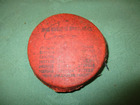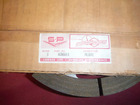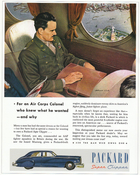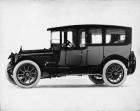|
Re: Larry's 1951 Club Sedan Project
|
||||
|---|---|---|---|---|
|
Home away from home
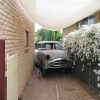
|
Ralph's Restorations
I've mentioned that a local 'Bathurstian' is the ace rust repair chap that has been doing the repairs on my Packard. Ralph started restoring cars and building rods way back in the 1960's, and has quite a number of full restorations to his credit. Here are a few pics of what he has 'in the shed' currently. Ralph,s town car is a '50 Ford Single Spinner equipped with a Lexus engine, Jag independent rear end, 9inch diff etc. The car has power windows, auto trans, aircon and everything that opens and closes. Very comfortable . . .    Here is his '32 Ford Victoria. Powered by a blown Chev 350 it gets along very well. Ralph's great attention to detail makes this car a joy to behold.   Another couple of cars in the pipeline . . . Ralph's son has a considerable amount of work to complete this project. The '36 Ford 4-door (Oz made) will be chopped, slightly shortened and converted to Victoria style, with conversion to two lengthened doors. The new doors are the US 'rounded top' versions.  Another project well under way - Ford Pickup.  Ralph is able to take virtually any rusty auto remains, and craft them into something brilliant. His '51 Ford pickup was a very rusty proposition yet has been rebuilt strong and true and now presents as a beautiful restoration. A true credit to the metalworking craft.
Posted on: 2010/2/6 8:03
|
|||
|
1951 Packard Club Sedan | [url=ht
|
||||
|
||||
|
Re: Larry's 1951 Club Sedan Project
|
||||
|---|---|---|---|---|
|
Home away from home

|
Thanks Gregg, likewise have enjoyed your blog, we are moving along similar resto paths by the look of it.
That totally 'true barn find' pic (- your first photo)is amazing! Did you have chickens roosting in your 120? Interior looks to be in good condition. I had rats nesting in mine for a short while when it was stored. The blue - a very nice colour, will look great.
Posted on: 2010/2/20 6:54
|
|||
|
1951 Packard Club Sedan | [url=ht
|
||||
|
||||
|
Re: Larry's 1951 Club Sedan Project
|
||||
|---|---|---|---|---|
|
Home away from home

|
Replacing the Rear Axle Seals
Replacing the rear axle inner and outer oil seals was fairly routine and as outlined in the '51-54 Service Manual, with a few exceptions. Thought it might be helpful to others to describe where I sourced my 1951 seals, and also the method I had to use to remove one of the inner seals that was very reluctant to shift. Firstly, rather than order from Kanter I was able to obtain seals in Australia from ABC Bearings. A phone call and emailing a few photos of the genuine Packard seals I had removed, together with accurate dimensions assisted ABC in sending me the appropriate ones. As is seen in the photos here, the original Packard outer seals consist of three parts - the grease guard plate, a 'cow-hide' seal and a retaining ring. The retaining ring is a tight fit in the plate and care needs to be taken in removing it to avoid damage to the plate. If using the type of replacement that I used then the retaining ring will not be required. The new type neoprene seal should be a tight press fit into the plate, tapped in using a socket, or piece of pipe almost the same diameter as the seal. Rear axle outer seals    Removing one of the inner seals was very difficult. I had checked in packardinfo.com the type of Packard tool that was used in the Manual. J-943-B is the recommended tool, and no photo is available in the manual, however a diagram of the tool can be found in the Packard Literature and Manuals, it is on page 34 of the 1950 Packard Kent-Moore Service Tool Guide. NOTE: Index towards front gives page numbers for a particular area, e.g. Rear Axle is indexed on page 65. Diagram of the tool is on page 34. When I saw the picture of the tool I noted that it was unlikely to be good enough to remove the seal I had that was tight. So I modified a slider hammer (see pic) and tried for ages to 'hammer' the seal out but to no avail. Next I bent up some steel strap (heavy stuff - 3/16inch thick, see photo) so I could apply pulling power via a 3-pound hammer. Even using this method it took a long time to get the seal out. I gave up on moving the effort around the seal evenly, in the end I just kept using my fabricated puller in the one spot. The photo shows just how much effort was needed to get the seal out.   Slider hammer (which removed the RHS seal easily), and the special 'heavy duty' puller I fabricated. 'The persuader' - this one did the trick (eventually).  When it finally came away the LHS seal was very distorted. Yet the RHS seal was removed very easily.  Inner seals  Replacing the inners was straightforward, using a suitably sized socket and piece of heavy-walled pipe. The Australian ABC product codes can be seen in the photographs.
Posted on: 2010/2/20 7:13
|
|||
|
1951 Packard Club Sedan | [url=ht
|
||||
|
||||
|
Re: Larry's 1951 Club Sedan Project
|
||||
|---|---|---|---|---|
|
Forum Ambassador
|
Glad ABC Bearings were able to source and supply the seals for you Larry.
Posted on: 2010/2/20 9:27
|
|||
|
Mal
/o[]o\ ====  Bowral, Southern Highlands of NSW, Australia "Out of chaos comes order" - Nietzsche. 1938 Eight Touring Sedan - SOLD 1941 One-Twenty Club Coupe - SOLD 1948 Super Eight Limo, chassis RHD - SOLD 1950 Eight Touring Sedan - SOLD What's this?  Put your Packard in the Packard Vehicle Registry! Here's how! Any questions - PM or email me at ozstatman@gmail.com |
||||
|
||||
|
Re: Larry's 1951 Club Sedan Project
|
||||
|---|---|---|---|---|
|
Home away from home

|
It was very good to get the bits locally! Thanks again for putting me in touch with ABC.
I found they have some very helpful people working there.
Posted on: 2010/2/20 17:43
|
|||
|
1951 Packard Club Sedan | [url=ht
|
||||
|
||||
|
Re: Larry's 1951 Club Sedan Project
|
||||
|---|---|---|---|---|
|
Home away from home

|
Back home after a few weeks away seeing our grand-daughter
in Melbourne, and taking a few extra days to stop at a few camping spots down the south coast . . . beautiful. Now it's great to be back and getting some more done on the '51. I had a few dents in the tank, so thought I'd mention a means of petrol tank dent repair. Having a few small dents in the petrol tank was more of a problem with appearance than performance, but I wanted to get rid of them anyway. Looked around for some ideas for removing them, and came across this particular method, which works for some mild dents, but is not much use with sharply creased dents, dents in thick metal, etc. You can buy a kit from 'Ding King' which works on the same principle, but I made do with a hot glue gun and some bits and pieces I had laying around. There are a lot of people out there who are ready to spend large amounts of money on dent removal, but I'm not inclined to do that on a fuel tank where the dents are completely hidden from view. Most methods utilize heat and pressure to pop a dent out of a tank, but the risks of either explosion or distorting your tank are high, as is the cost. We've all heard the stories about fuel tanks exploding - even when almost filled with water. I used the following: - hot glue gun - coach bolt with some of the head ground away, and several large washers, 2 nuts - cupped washer (- this looked like a shock absorber cup washer) - the larger the diameter the better - piece of sturdy angle iron approx 1.5 x 1.5 x 18 inches - butane gas torch (small one will do) - 240 grit wet and dry for roughing and cleaning the area. You can see from the pics how it is done. Here are the materials: In this photo just to the right of the puller you can see where I have been able to pull out an earlier dent reasonably well and have set up the unit ready to remove another dent.  Best if the bolt cannot turn in the cup washer, so you can either weld the washer to the bolt or use the squared part of the upper shank in a squared hole in the washer to prevent turning when tightening. (I filed the round hole to square with a three-cornered file). Oiling the nut also helps prevent twisting, but be careful that no oil gets onto the surfaces where the glue will be. Sand the area to improve adhesion and clean thoroughly with thinners or metho. A word of warning - keep the petrol cap / drain cock etc tightened and ensure that no petrol fumes are present when you have the torch alight! (A slightly safer method of sealing the tank is to stuff rag down the filler neck then tape plastic sheet over it. This can prevent the tank from exploding as the rag blows out and vents the tank, whereas a petrol cap doesn't give way). The procedure of heating the small area slightly to melt the glue is dangerous if there are any fumes around. Prevent fumes. If in doubt then give it a miss! I melted plenty of glue into the cup washer, keeping it very hot, and quickly pre-heated the tank area also, then sat the cup with the liquefied glue onto the tank immediately. What I found is that you need to give the glue time to really harden, so allow around 30 minutes or longer. The bond gets stronger over time. Here is the puller set up and ready to go:  You can easily pull the metal too far so take care to not be tightening the nut too much. Some dents near corners etc will come a little way but the glue bond will give way before you get the dent all the way out. More 'pulling power' can be gained by gluing a larger area. This pic is showing the glue bond just starting to give way. The dent has been almost removed at this stage. 
Posted on: 2010/4/9 5:45
|
|||
|
1951 Packard Club Sedan | [url=ht
|
||||
|
||||
|
Re: Larry's 1951 Club Sedan Project
|
||||
|---|---|---|---|---|
|
Webmaster
|
Have you tired using one of these to remove dents?
harborfreight.com/cpi/ctaf/Displayitem.taf?itemnumber=3223 They work great and all you really have to do it twist the stud to remove it from the metal when done leaving almost no cleanup to be done. The rear drivers side door "scallop" was pretty caved in on my Clipper from a pervious accident, and I pulled the entire dent out using one of these. It works great anywhere that you don't have access to the backside of the panel. It only take about 1 second to weld the stud to the panel. Any longer and it will penetrate too deeply. Also because it concentrates the weld at the head of the stud, there is no worry of heat damage to the panel.
Posted on: 2010/4/9 11:20
|
|||
|
-BigKev
1954 Packard Clipper Deluxe Touring Sedan -> Registry | Project Blog 1937 Packard 115-C Convertible Coupe -> Registry | Project Blog |
||||
|
||||
|
Re: Larry's 1951 Club Sedan Project
|
||||
|---|---|---|---|---|
|
Home away from home

|
Thanks Kev, that unit (and no doubt others) would be brilliant to have in my toolkit!
Just recently used a fairly big version of a stud welder with multiple pin capacity (brand is 'EasyBeat') to pull out dents behind a few blind panels - and it worked great. The problem is that was a borrowed unit, and quite expensive (around $1500 Aus) so too pricey for me. I have looked for an Oz handheld gun like the one you mentioned, and - unbelievable as it seems, there are none available here as far as I can tell! I even placed a call to a large welding supplies distributor - http://www.nationalwelding.com.au/?gclid=CKyPmaj--qACFQsXewod-gaUvQ to enquire and they haven't seen an Oz version. Would like to import the US one but the problem is 120VAC as opposed to 240 VAC we use. I might yet import one and use it with a 240 to 120V transformer . . . . Just one benefit of the method suggested for petrol tanks - possibly a stud welder would be more likely to ignite any vapour inside the tank, as it could possibly spark inside the tank. So I erred on cautious side because I think the 'glue stick' method is fairly safe providing fumes outside the tank are not present. You need only heat the washer / bolt assembly at a safe distance from the tank, if in doubt. My tank hasn't been used for around 40 years - definitely not even a whiff of petrol present!
Posted on: 2010/4/9 21:05
|
|||
|
1951 Packard Club Sedan | [url=ht
|
||||
|
||||
|
Re: Larry's 1951 Club Sedan Project
|
||||
|---|---|---|---|---|
|
Webmaster
|
The trick there is to fill the tank with water while you are welding the pins.
Most of Harbor's stuff is made in China, hence why the prices are so low. While they are not the same quality as the expensive tools, they get job done. For the casual use they work great. All my high-use hand tools (screw drivers, wrenches ,etc) are craftsman, gear-wrence and some vintage Snap-on mixed in. But for those tools you only use once in a blue-moon, the Harbor Freight that is 1/2 mile from the house is a godsend, and the price is right.
Posted on: 2010/4/9 21:38
|
|||
|
-BigKev
1954 Packard Clipper Deluxe Touring Sedan -> Registry | Project Blog 1937 Packard 115-C Convertible Coupe -> Registry | Project Blog |
||||
|
||||


